Twenty twenty has been a challenging year for most people and industries. But it was particularly unfortunate for watch lovers in that 2020 also marked the 175th anniversary of Glashütte’s watch industry as well as the thirtieth anniversary of its renaissance in 1990. Many had hoped for (and sincerely missed) special events and glimpses of new timepieces at the traditional spring trade shows.
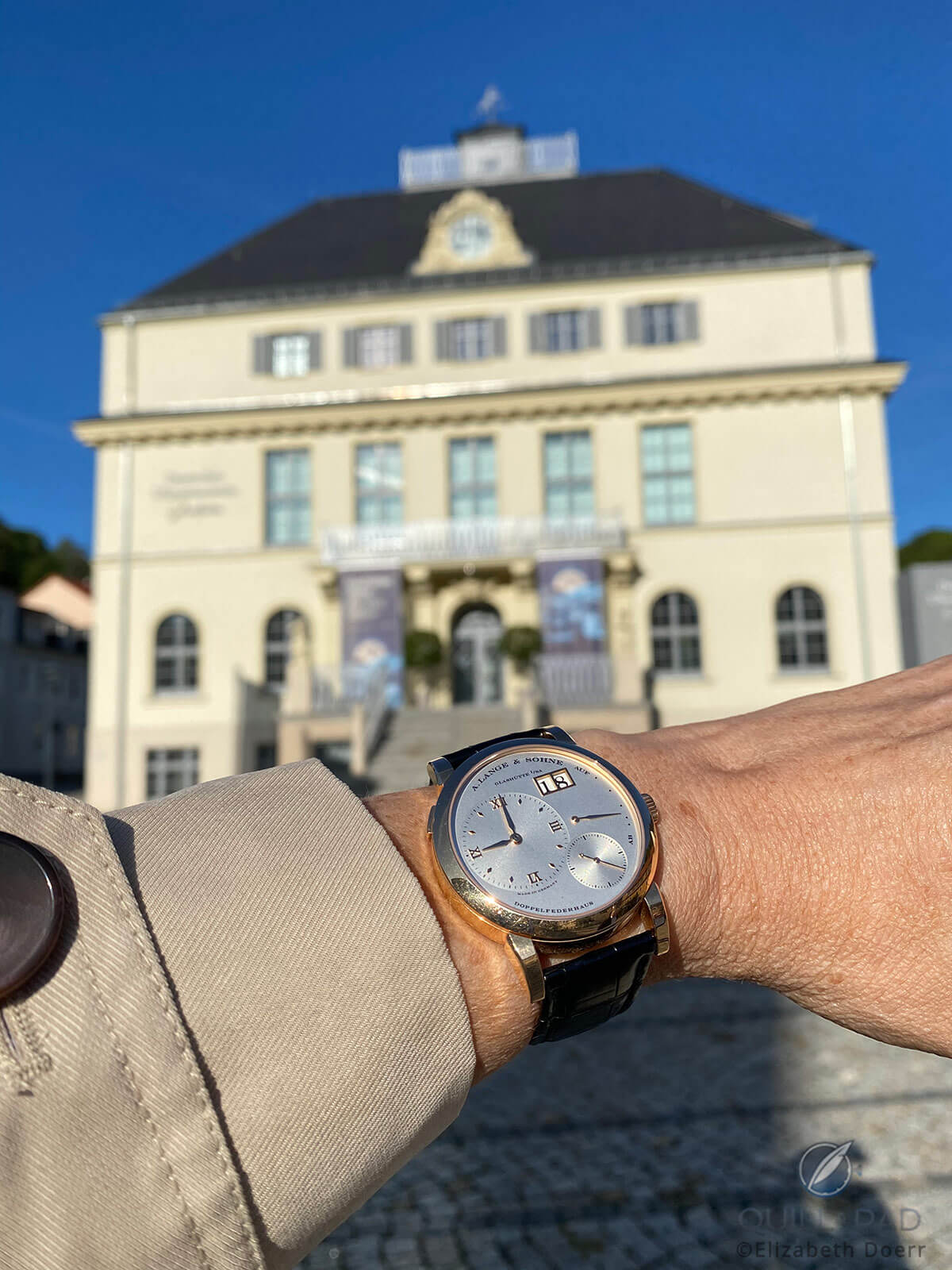
September 18, 2020: the A. Lange & Söhne Lange 1 celebrates one of only two in-person 175th anniversary events in Glashütte
However, due to the COVID-19 pandemic and ensuing restrictions most of this was canceled, with only two in-person events able to go forward in any way.
One of these was the inauguration of Walter Lange’s memorial statue on September 18, 2020. The great-grandson of Ferdinand Adolph Lange initiated the transformation of the local watch industry into one of the finest of our time when German reunification offered the chance of a new beginning as of 1990.
The fitting tribute to this grand seigneur of watchmaking, who passed away in 2017, is on the freshly refurbished church square vis-à-vis the memorial monument to Ferdinand Adolph Lange and was unveiled during a small ceremony with local and German personalities as well as just a handful of well-spaced friends of the brand.
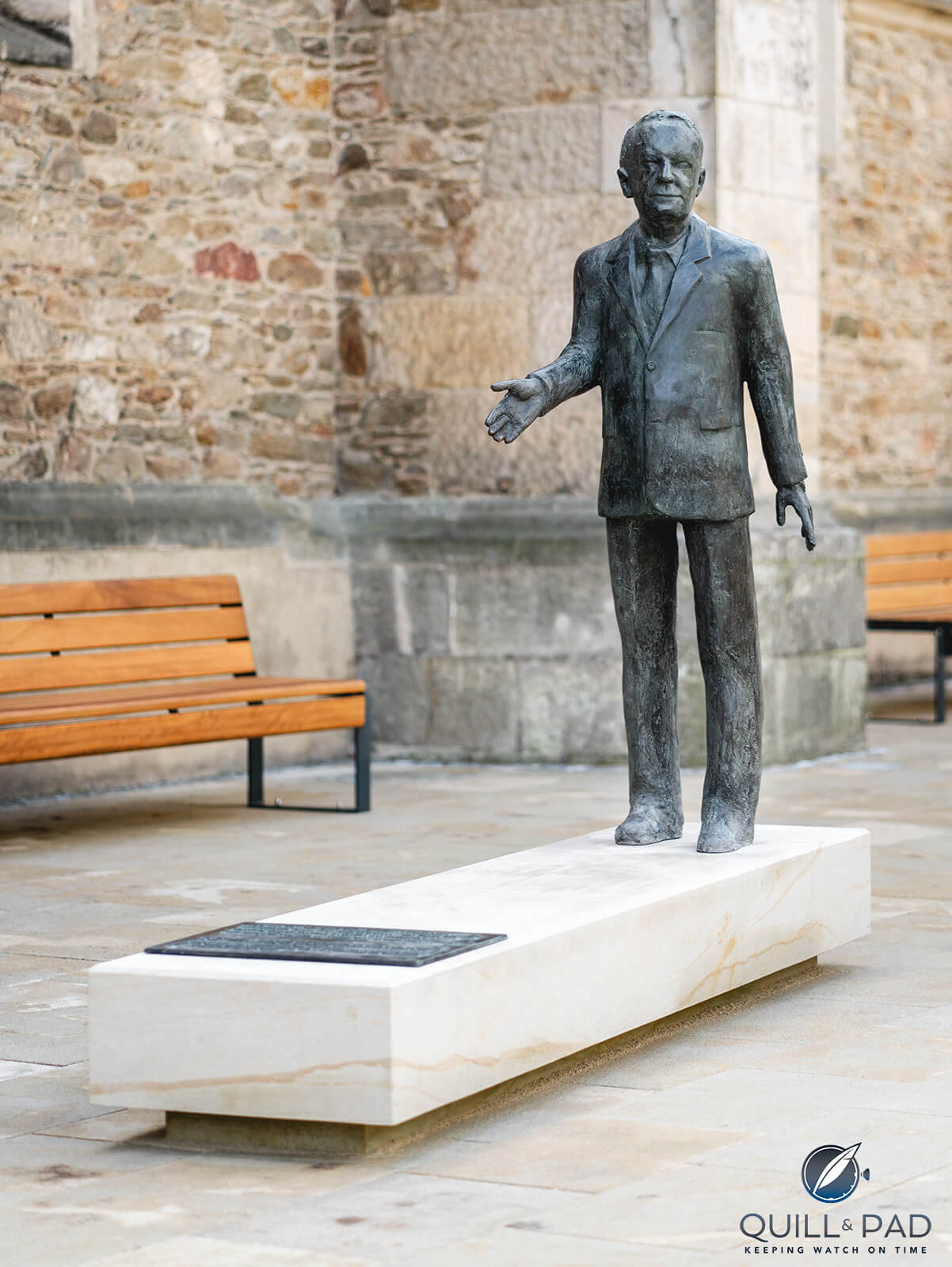
Walter Lange memorial statue unveiled in Glashütte, Germany on September 18, 2020
On the same day, the German Watch Museum Glashütte opened a special exhibition dedicated to the early years entitled “Glashütte Watches – How It All Began,” which explores the first 25 years of the city’s tradition in watchmaking after the founding father, Ferdinand Adolph Lange, inaugurated the first watchmaker workshop in the small town.
Lange both laid the foundation for the Saxon watch industry, which soon became recognized worldwide for its high precision and excellent quality, and provided an economic boost to the region. Under his aegis, the economically underdeveloped town transformed into a flourishing business location offering secure, fairly paid jobs and brought modest prosperity to the people of Glashütte.
A true visionary, Lange also supported talented colleagues like Julius Assmann, Adolph Schneider, and Moritz Grossmann, founder of the German School of Watchmaking. In the second half of the nineteenth century, their competence and tireless diligence fuelled economic growth and the technical development of local watch movements. Their legacy remains an important one to this day and continues to inspire the watchmakers of Glashütte.
The museum’s exhibition is currently slated to run until April 18, 2021. However, the museum has been closed for two months due to Germany’s strict COVID-19 restrictions as of press time.
The only other event taking place in celebration of 175 years was the one-day Nomos Forum, which featured an interesting historical talk by head watchmaker Mirko Heyne, a fascinating discussion of the work of Doctors Without Borders led by previous international board member and Berlin-based doctor Tankred Stöbe, and the introduction of a new watch (see Nomos Glashütte Lambda In Stainless Steel: Celebrating 175 Years Of Fine Watchmaking In Glashütte).
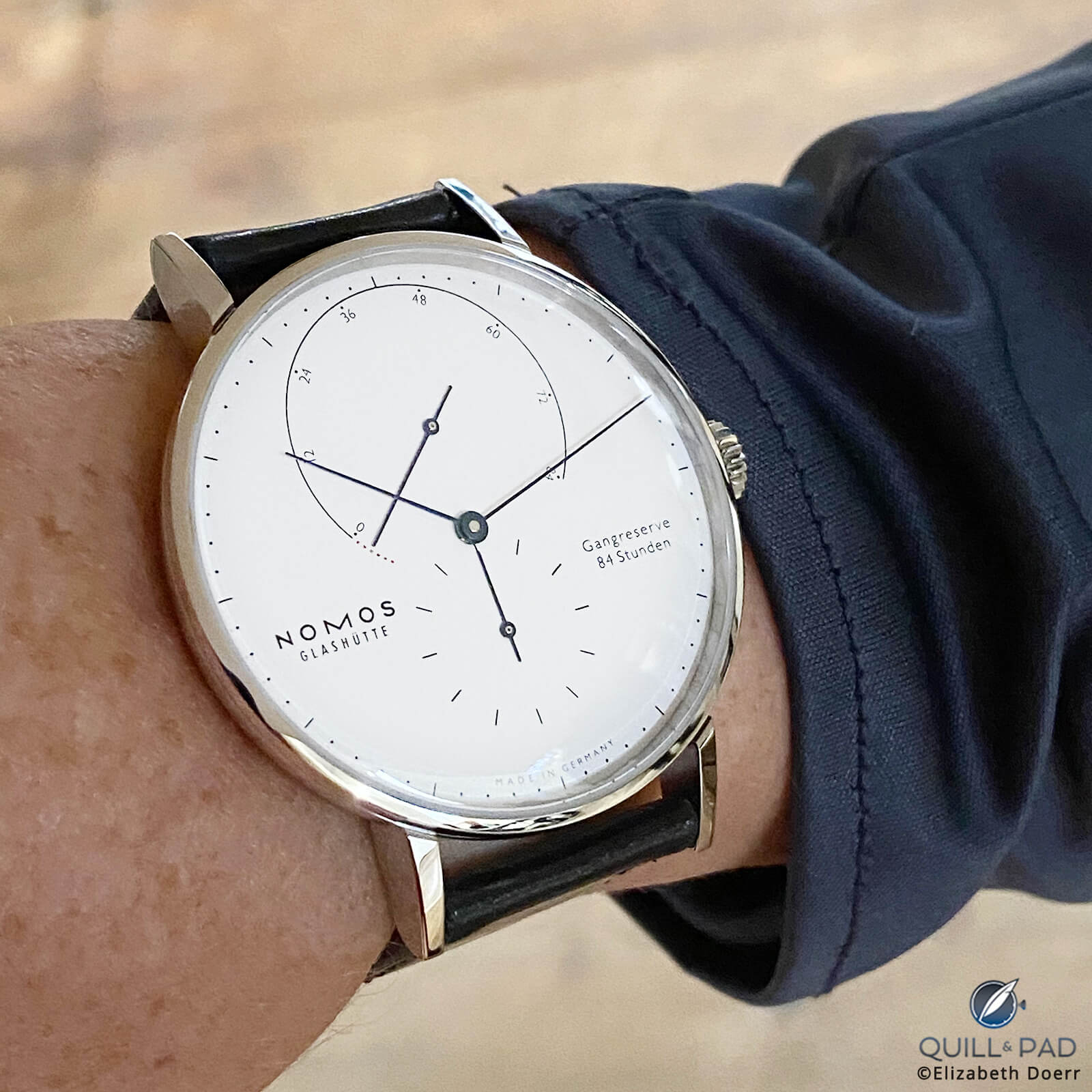
Nomos Glashütte Lambda stainless steel with white dial celebrating 175 years of Glashütte watchmaking
In celebration of 175 years of this unique Saxon microcosm in the Erzgebirge, Glashütte’s modern watchmakers have come up with some amazing timepieces – ranging from entirely new collections like Wempe Glashütte’s Iron Walker to intricate grand complications such as Glashütte Original’s PanoLunar Tourbillon Limited Edition and innovative new twists on existing classics like A. Lange & Söhne’s Lange 1 Time Zone. The year’s new watches also included sporty highlights like Tutima Glashütte’s Grand Flieger Airport Chronograph.
There have been many debuts to delight connoisseurs of Saxon horology. Here are four of my favorites, all limited special editions, that I will keep in my heart as personal highlights from the year that turned the world upside down (and will thankfully very soon come to a close).
A. Lange & Söhne 1815 Thin Honeygold Homage to F.A. Lange: the essence of Saxon high horology
The magnificent story of Glashütte was born from the vision of one genius watchmaker – Ferdinand Adolph Lange – who brought wellbeing and eventually fame to this forgotten corner of the kingdom of Saxony 175 years ago. With hard work, dedication, and the help of like-minded watchmakers and friends Lange established a reputation synonymous with the highest art of horology.
And this spirit is still very much alive, not only in the company he once started but in the entire Glashütte watchmaking community.
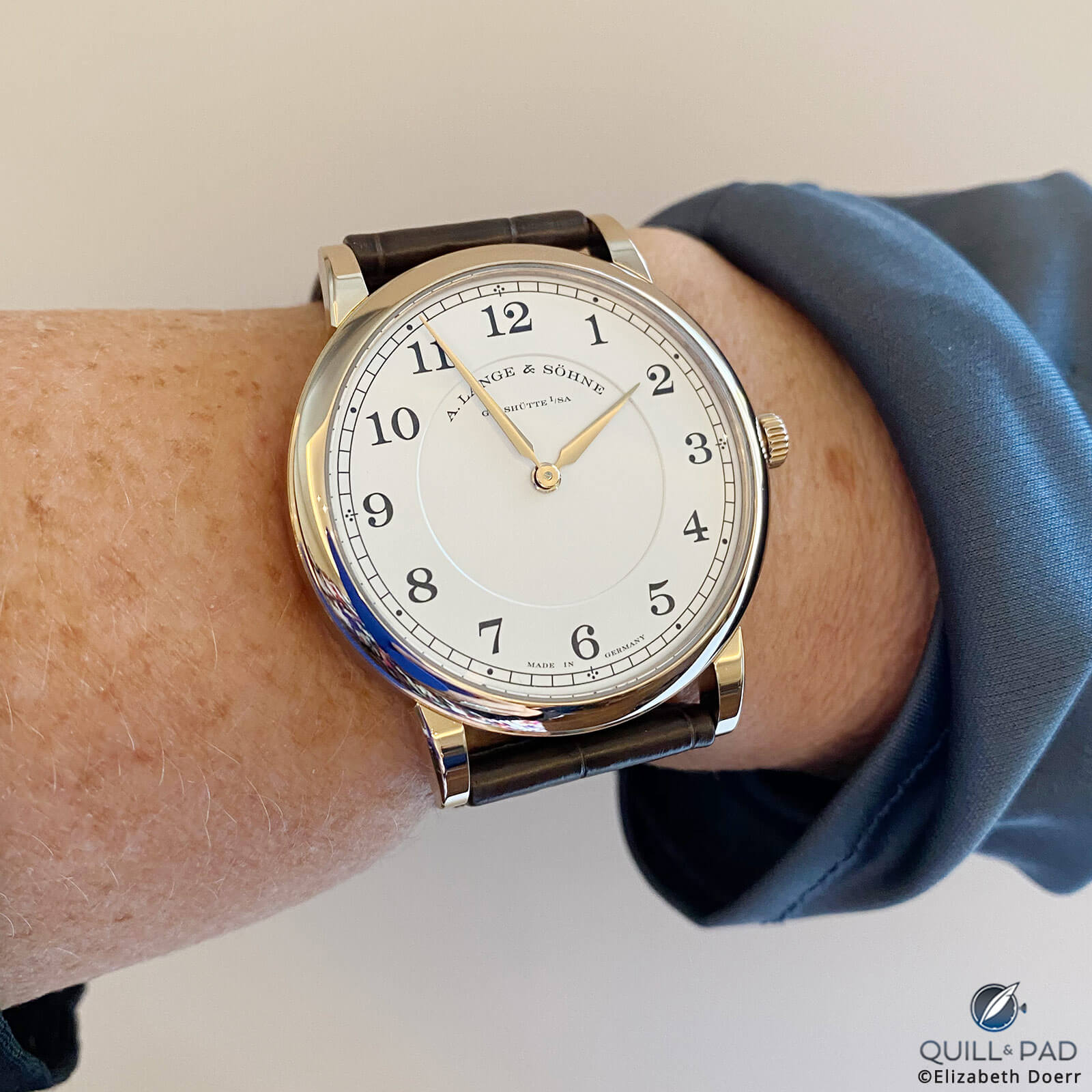
A. Lange & Söhne 1815 Thin Honeygold Homage to F.A. Lange on the wrist
Among other notable new timepieces in 2020, A. Lange & Söhne introduced a limited set of three watches as an ode to the brand’s founding father offering at times super complicated, always extremely detailed, and of course extraordinarily finished timepieces, all clad in Lange’s proprietary honeygold alloy. In addition to the 1815 Thin Honeygold Homage to F.A. Lange, the set includes the 1815 Rattrapante Honeygold Homage to F.A. Lange and the Tourbograph Perpetual Honeygold Homage to F.A. Lange.
These watches highlight the Saxon brand’s technical prowess, particularly the 1815 Rattrapante Honeygold Homage to F.A. Lange, which combines a split-second chronograph with a perpetual calendar.
The dial of the Tourbograph Perpetual Honeygold Homage to F.A. Lange is also a work of art, incredibly refined with numerals and indications rising in relief from the honeygold base, which is treated with a black rhodium-plated finish. With its intriguing granular surface, I would not be surprised to learn that this masterpiece was one of the most-desired watches by discerning collectors in 2020.
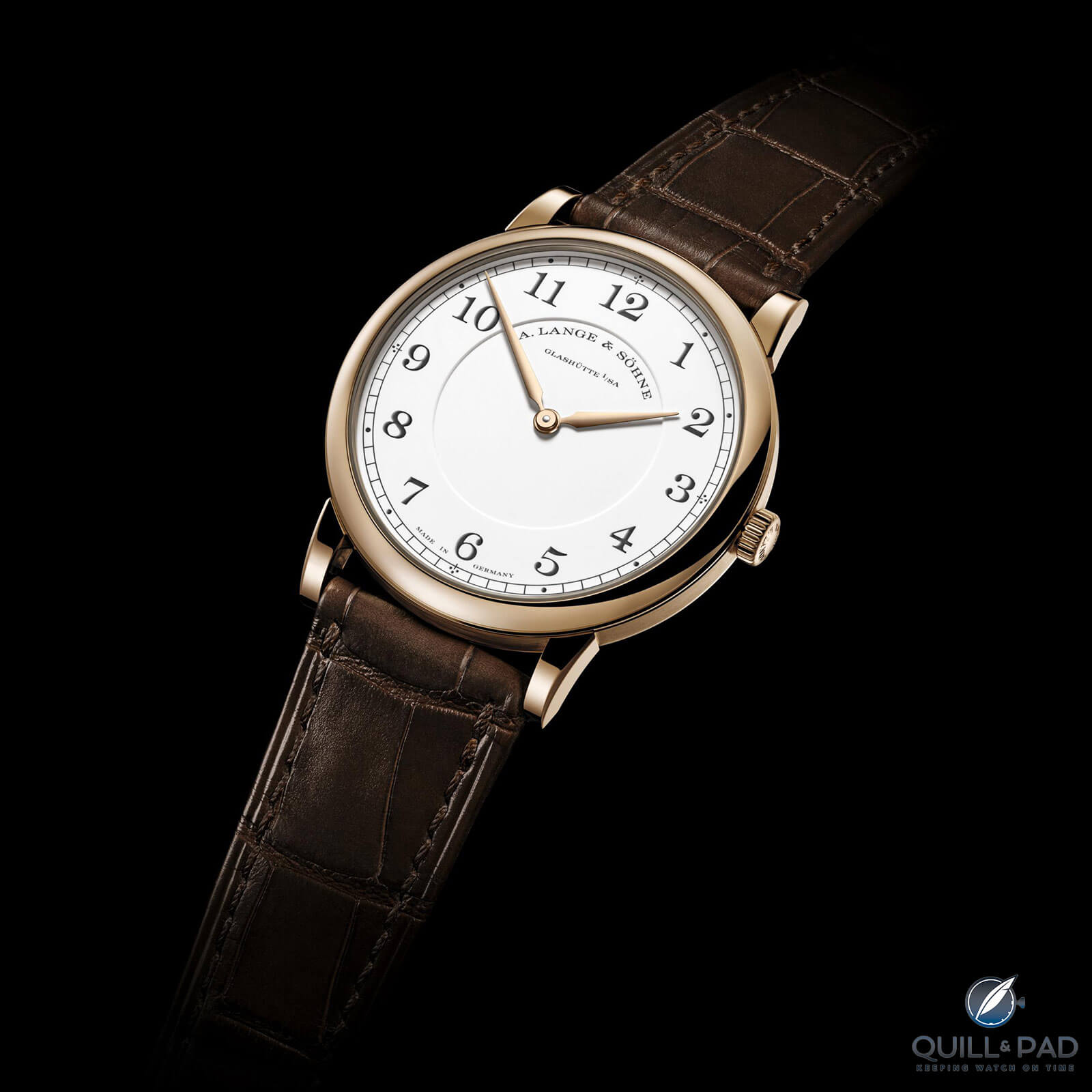
A. Lange & Söhne 1815 Thin Honeygold Homage to F.A. Lange
However, I instantly fell in love with the 1815 Thin Honeygold Homage to F.A. Lange, an elegant, time-only model that is a picture-perfect example of the beauty of simplicity, reviving the simpler style of A. Lange & Söhne’s early pocket watches. Its glossy white enamel dial with large Arabic numerals and railway-track minutes exudes an unmatched timeless aura.
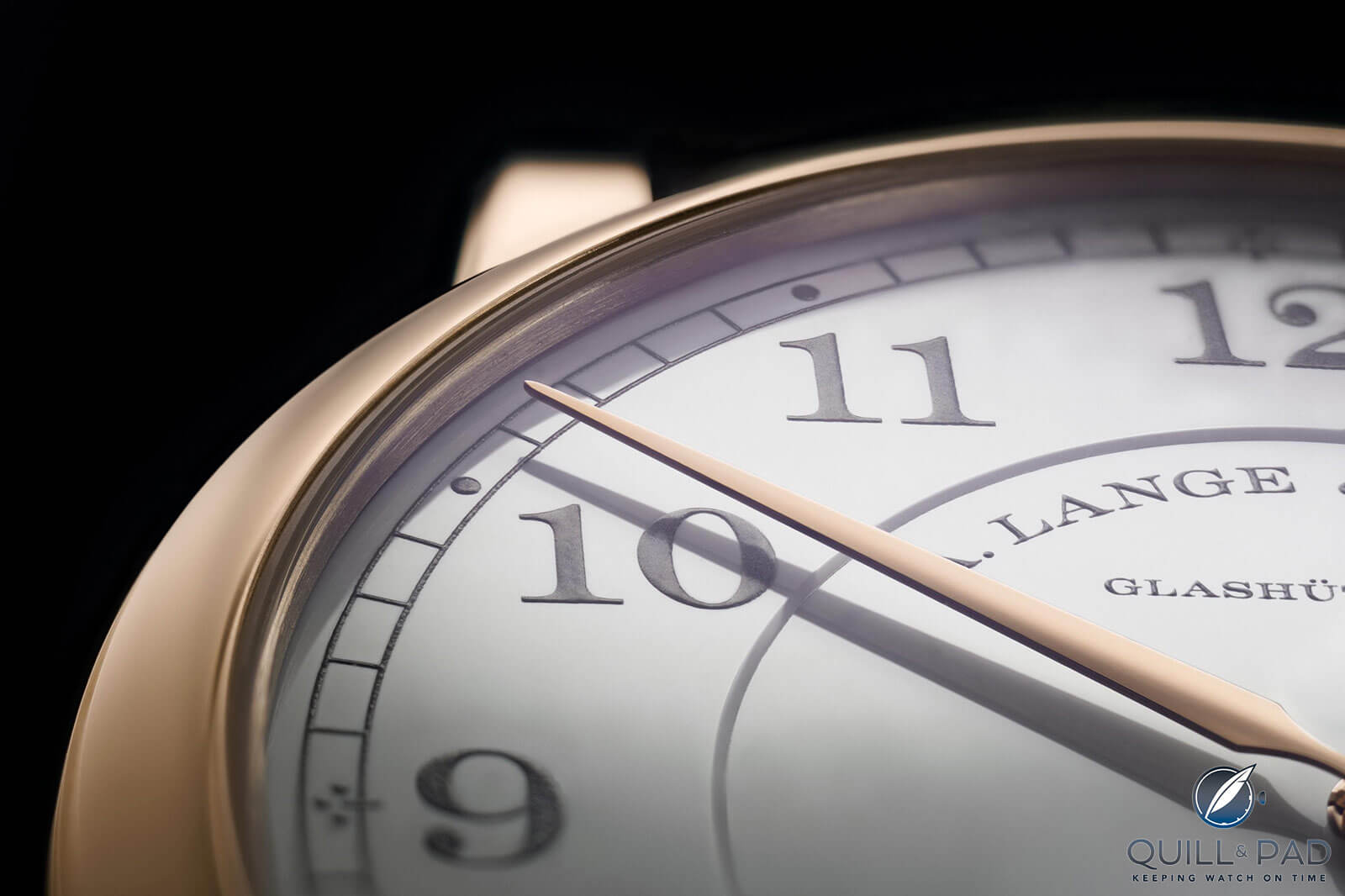
A. Lange & Söhne 1815 Thin Honeygold Homage to F.A. Lange dial details
This watch is all about legibility so it is very much in line with Lange’s ideals, which were all about precision. His maxim was that a perfect watch had to be a simple one.
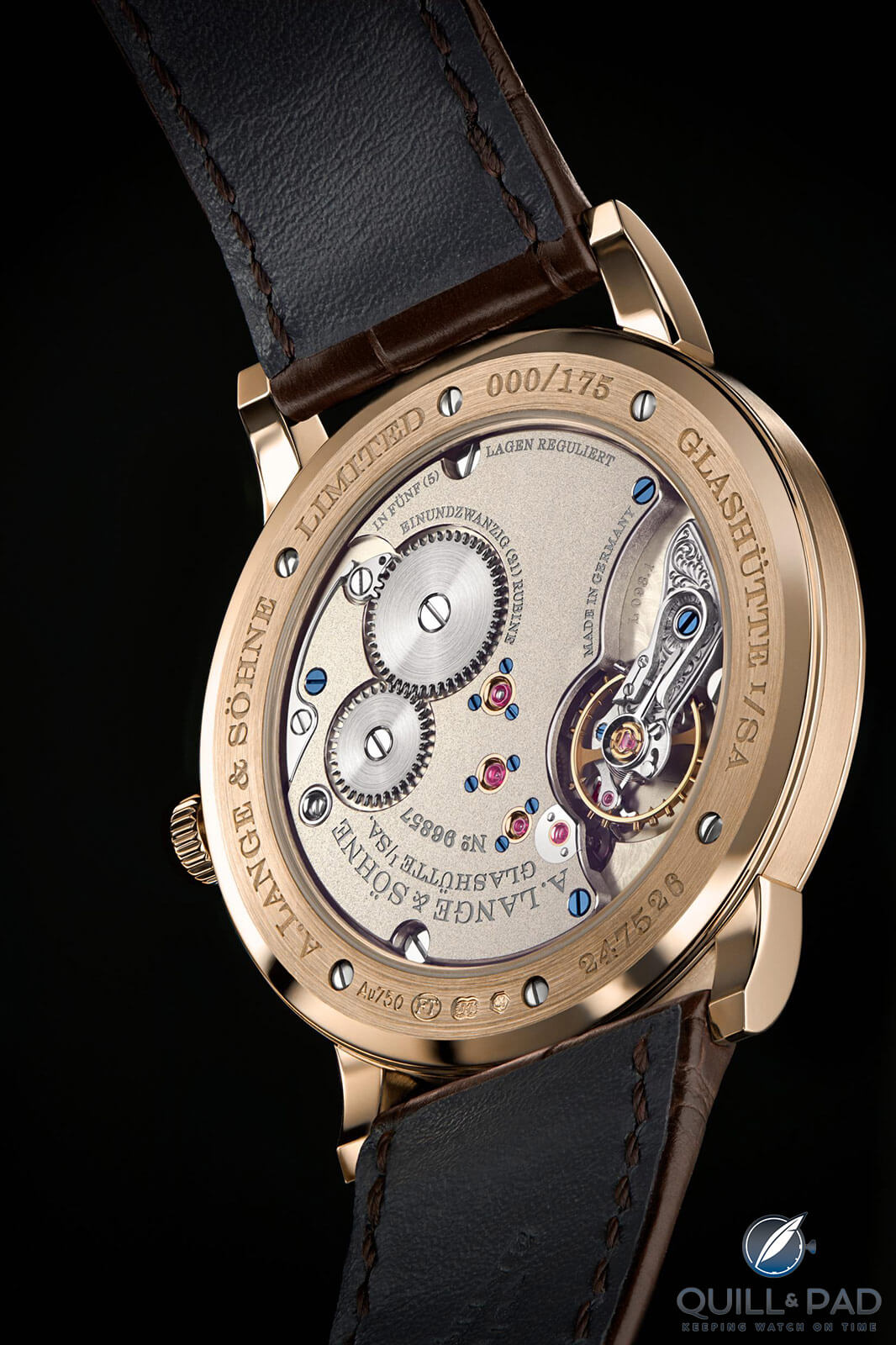
Back of the A. Lange & Söhne 1815 Thin Honeygold Homage to F.A. Lange
Well, the ultra-thin movement at the heart of the timepiece measuring only 6.3 mm in height is anything but simple. Comprising 167 components, manually wound Caliber L093.1 is only 2.9 mm high. It features many of the sought-after A. Lange & Söhne hallmarks including a swan-neck fine adjustment, manually engraved balance cock, and signature decorations such as beveled edges and gold chatons.
In a nod to history, the three-quarter plate made of German silver has a granular finish instead of the classic modern Glashütte ribbing.
For more information, please visit www.alange-soehne.com/en/timepieces/1815-thin-honeygold-homage-f-lange.
Quick Facts A. Lange & Söhne 1815 Thin Honeygold Homage to F.A. Lange
Case: 38 x 6.3 mm, honeygold
Movement: manual-winding manufacture Caliber L093.1, 3 Hz/21,600 vph frequency, 72-hour power reserve
Functions: hours, minutes
Limitation: 175 pieces
Price: $32,200/€32,200
Glashütte Original Senator Chronometer – Limited Edition: sailing the seas with style and precision
As expressed in the brand name, Glashütte Original’s concept is deeply rooted in the horological history of the Saxon town and goes all the way back to its beginnings. Today operating under the aegis of the Swatch Group, Glashütte Original is devoted to the production of timepieces fulfilling the highest technical and aesthetic standards associated with fine watchmaking à la Glashütte. The company preserves the ideals of craftsmanship and technical ingenuity, regularly reviving historic milestones in new timepieces.

Glashütte Original Senator Chronometer – Limited Edition in white gold
This is true for the Senator Chronometer – Limited Edition, an homage to the early days of chronometer making of the 1870s.
Although they came about in Glashütte’s watchmaking a little later than other European countries, like France and England, the town’s marine chronometers soon became sought after thanks to their certified high precision (maximum deviation of -0.3 seconds per day) and resilience. Precious scientific tools, marine chronometers had to pass strict testing regimens and quality specifications.
Many famous chronometer makers and regulators worked in Glashütte, among them Paul and Fridolin Stübner and Paul Thielemann. It is noteworthy that even in the 50 years of divided Germany the production of marine chronometers never ceased.
Marine chronometers were the number one expert product of the VEB Glashütter Uhrenbetriebe “GUB” combine from which Glashütte Original emerged after reunification. Locked behind the Iron Curtain in the socialist country, the combine nonetheless delivered thousands of them, helping ships navigate before GPS finally seeped into all corners of the world.

Glashütte Original Senator Chronometer – Limited Edition in white gold
Glashütte Original’s limited edition of the Senator Chronometer, a model first introduced in 2009, goes back to very beginning of this chapter in Saxon watchmaking history. Its dial, which is manually silver-plated in this version, has a stunning grained surface that eliminates light reflection and offers excellent legibility.

The dial of the Glashütte Original Senator Chronometer – Limited Edition
And what a pleasure it is to look at this beauty with its elegant, slightly elongated Roman numerals, railroad minute track, blued hands for all indications – including the Saxon-style power reserve indicator called the “Auf und Ab,” as well as prominent subsidiary seconds – and, last but not least, the brand’s signature panorama date.
There is also a small day/night display integrated into the power reserve indicator. What makes this tasteful arrangement even more desirable is the new case design with a slimmer bezel distinguished by a flange, which adds serious depth to the overall look.
Although Glashütte Original’s significant design is what catches the eye first, admirers can’t wait to go deeper into its inside values. For sure they won’t be disappointed when they look through the exhibition case back where the hand-wound, chronometer-certified Caliber 58-03 sets the pace. It is equipped with a hacking second function to allow the owner to set the time to the second.

Movement of the Glashütte Original Senator Chronometer – Limited Edition
De rigeur for Glashütte Original, the movement, painstakingly finished to the highest standards, features a swan-neck fine adjustment and a balance cock engraved by hand. They stand out from the three-quarter plate that is silver plated and decorated with a galvanic coating in an awesome rose gold hue. The intriguing color makes for a stunning background, contrasting beautifully with the silvery wheels and barrel.
For more information, please visit www.glashuette-original.com/collection/senator/senator-chronometer-limited-edition.
Quick Facts Glashütte Original Senator Chronometer – Limited Edition
Case: 42 x 12.47 mm, white gold
Movement: manual winding manufacture Caliber 58-03, 4 Hz/28,800 vph frequency, 44-hour power reserve, German chronometer certificate
Functions: hours, minutes, hacking seconds, panorama date, power reserve indicator, day/night indicator
Limitation: 25 pieces
Price: $27,900 / €26,710
Moritz Grossmann XII Birthday Edition: silver lining
The dial is the most important visual element of a watch – usually we decide at first glance whether it appeals to us or not largely based on this one component. Although hardly larger than a coin, a dial offers countless design options, including color, texture, numerals, hand shapes, and displays.
Watch brands attach the greatest importance to the fact that all of the dial’s tiny elements are perfectly coordinated in order to achieve a harmonious and individual image. And in modern times, there are no limits to the design of this component.
However, even before electricity and chemical treatments like galvanizing and electroplating became available, clever watchmakers developed finishing processes to refine the dial and improve legibility. One of them is a rubbed silver-plating technique that creates a finely grained, almost velvety surface that reflects the light without creating a glare.
This particular technique was a favorite of Glashütte’s watchmakers in the nineteenth century, among them Moritz Grossmann (1826-1885).

Moritz Grossmann XII Birthday Edition in pink gold (left) and stainless steel
On the occasion of the twelfth anniversary of the high-end brand that bears the famous watchmaker’s name, founded by watchmaker Christine Hutter in 2008, Moritz Grossmann has produced a very limited edition of twelve timepieces that puts this beautiful and traditional craft in the spotlight.
To make the dial, a powder consisting of silver granulate, salt, tartar, and water is rubbed onto a carefully cleaned, degreased, and finely roughed brass base with the help of a small brush with boar bristles. But before that begins, all the dial’s numerals and engravings are filled in with black lacquer and fired in an oven. Since the powder does not adhere to the paint, these spaces are not covered by it. Slightly recessed, they create a harmonious contrast to the silky, silvery backdrop.
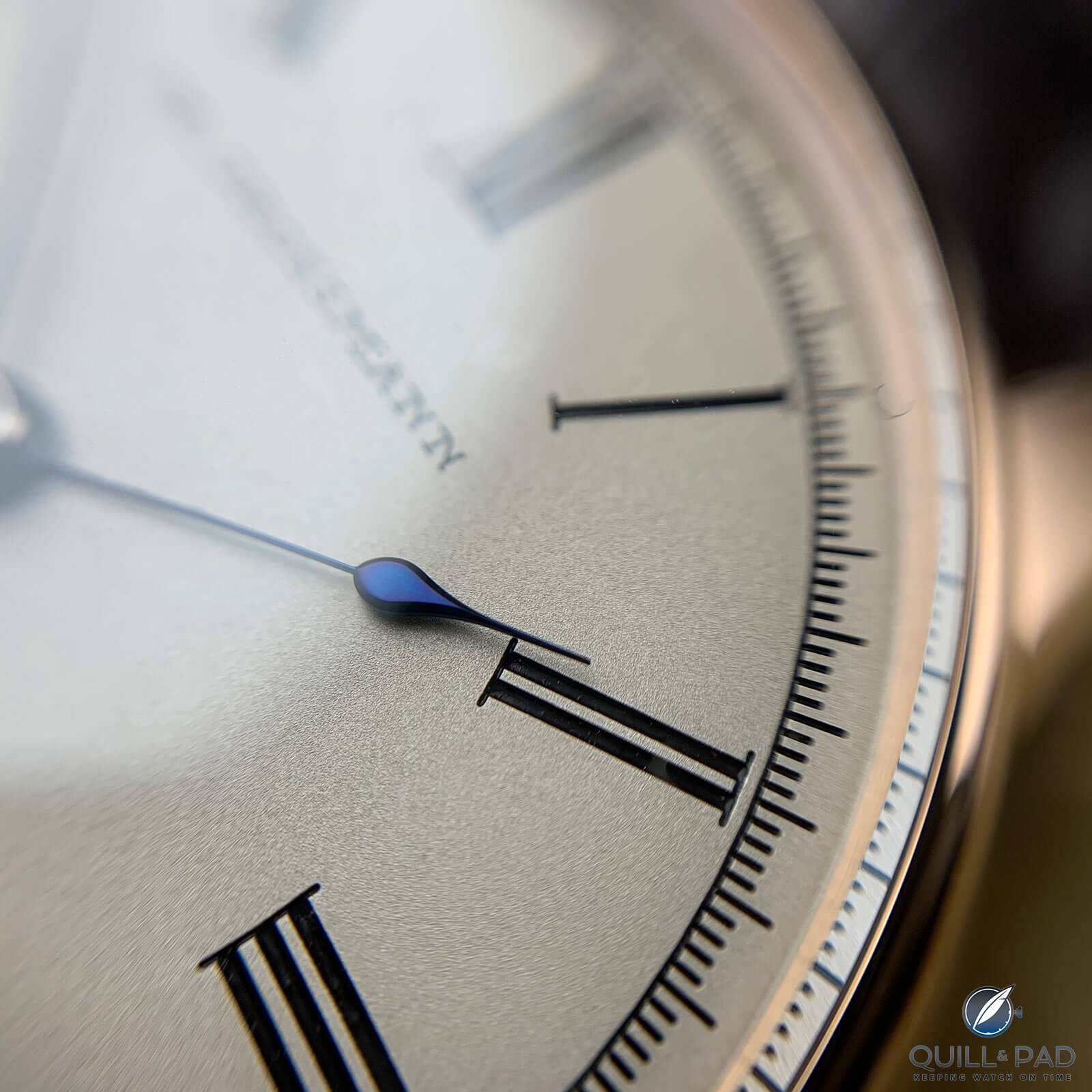
Dial details of the Moritz Grossmann XII Birthday Edition
At the end, the finely grained surface emerging after the polishing process is coated with protective varnish so that it retains its elegant appearance for a very long time. The stunning vintage aesthetic, complemented by delicately handcrafted blued hands, is highlighted by a slim bezel framing this gem of a dial.
Fans of this brand know that the elegant appearance of a Moritz Grossmann is always accompanied by a top-notch movement, usually with rare technical and aesthetic components.
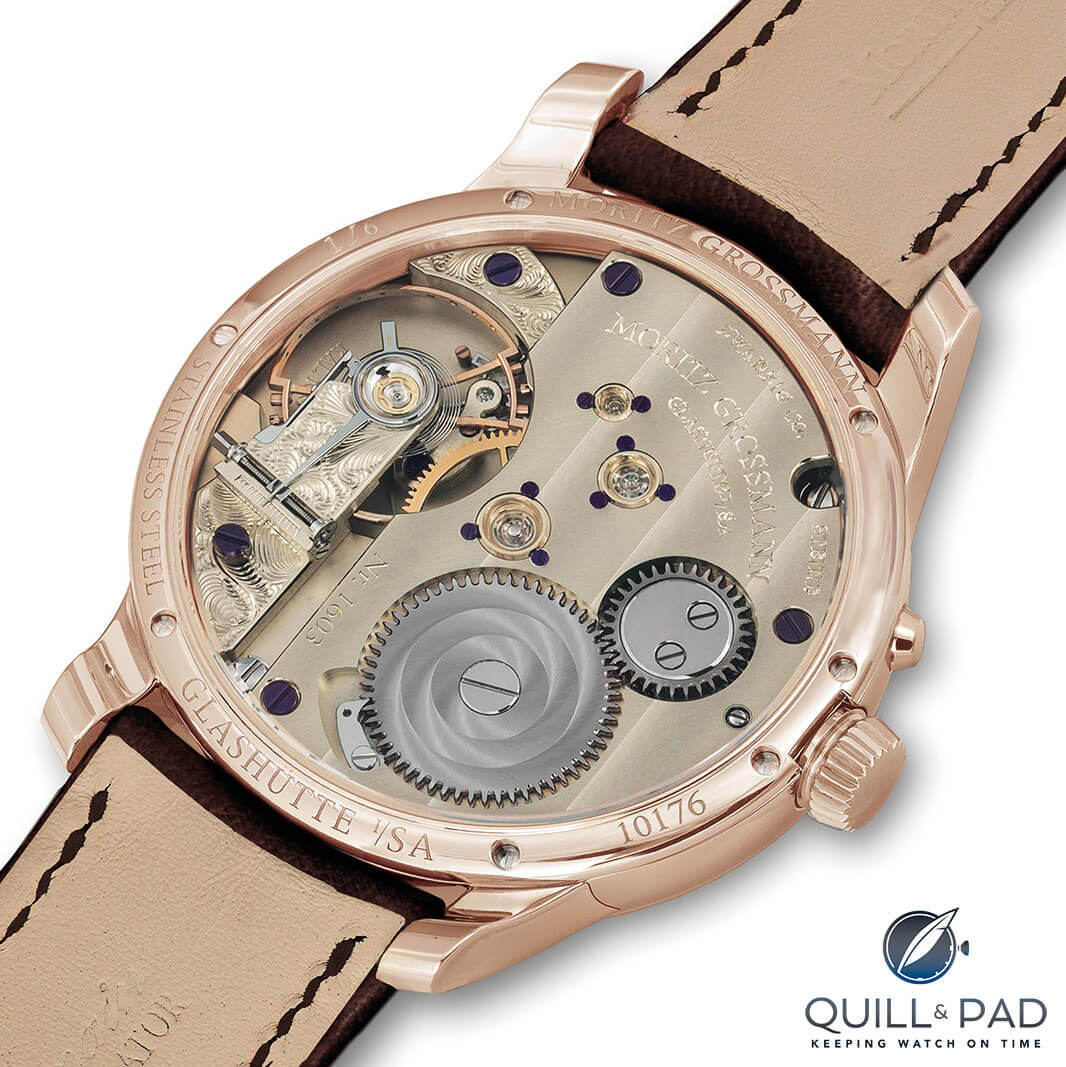
Movement of the Moritz Grossmann XII Birthday Edition
The XII Birthday Edition is powered by manually wound Caliber 100.1 consisting of 198 components, visible through its exhibition case back – which also reveals the two-thirds plate crafted in German silver decorated with Glashütte ribbing and including a Glashütte stopwork, a beautifully hand-engraved balance and escape wheel cocks, and triple snailing on the ratchet wheel, also a specialty of Moritz Grossmann. A highly visible Grossmann hallmark is the screws that are not blued but rather a brownish-purple hue achieved by tempering.
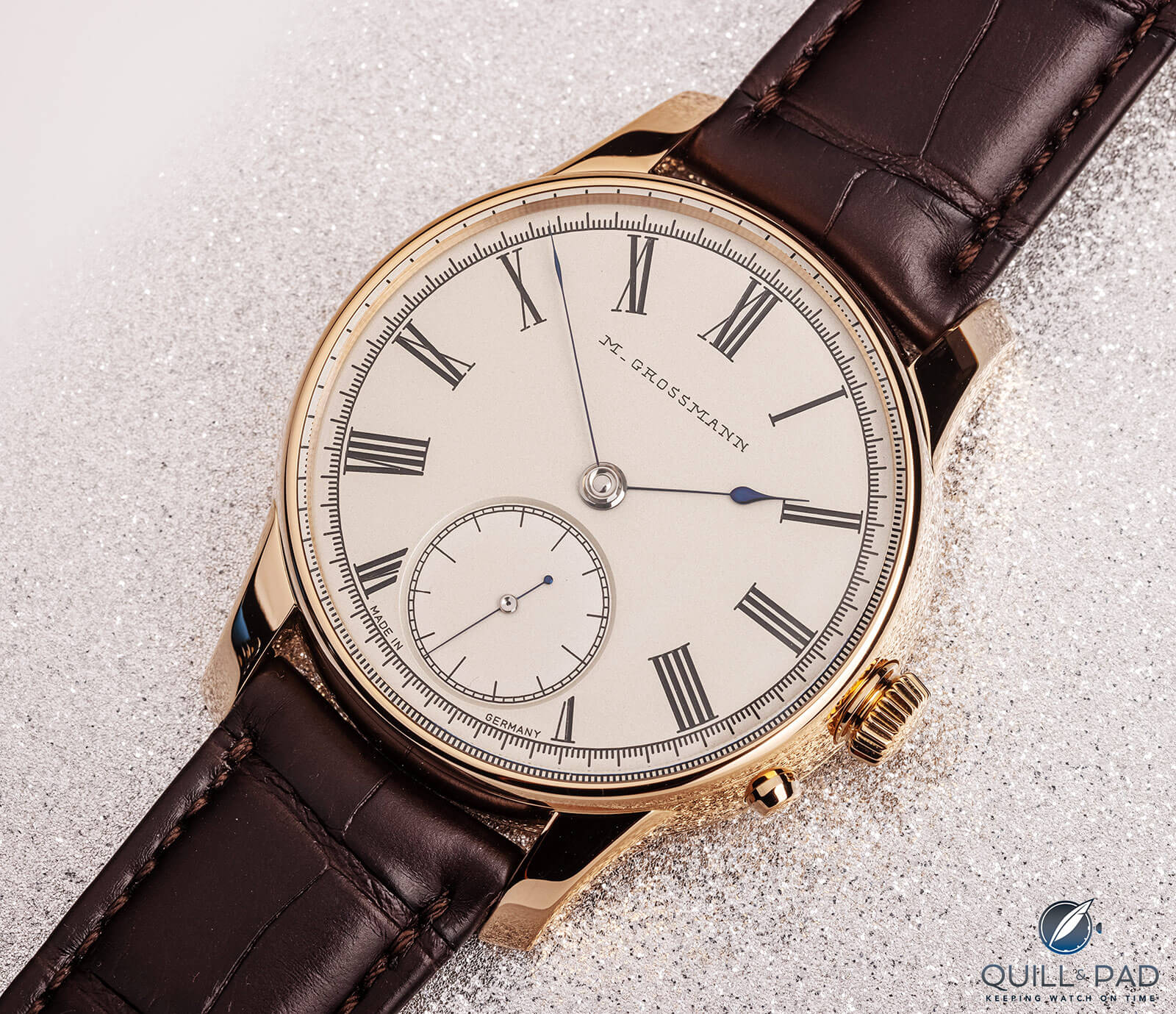
Moritz Grossmann XII Birthday Edition in pink gold
One sophisticated technical trait is the extra pusher for setting the time, which is placed below the crown. This proprietary mechanism helps avoid moving the hands unintentionally when pushing the crown back into place, while also preventing dust and moisture from entering the case.
For more information, please visit wwww.en.grossmann-uhren.com/watch/xii-birthday-edition.
Quick Facts Moritz Grossmann XII Birthday Edition
Case: 37.5 x 6.7 mm, stainless steel or pink gold
Movement: manual-winding manufacture Caliber 100-1, 2.5 Hz/18,000 vph frequency, 42-hour power reserve
Functions: hours, minutes, subsidiary seconds
Limitation: 6 pieces in each metal
Price: €19,100 (stainless steel); €27,600 (pink gold)
Nomos Glashütte Ludwig neomatik 41 Date – 175 Years of Watchmaking Glashütte: date with a twist
A story about the “capital” of German watchmaking would not be complete without a timepiece from Nomos Glashütte. Although the company has “only” produced watches since 1991, it is considered a shooting star that has significantely contributed to the renown of the town in modern times by offering high-quality mechanical timepieces at relatively affordable prices.
Nomos Glashütte’s watches are distinguished by a signature design language drawing from the Bauhaus school and the Deutscher Werkbund (German Association of Craftsmen). The brand has managed to evolve into a full-blown manufacture in a very short time and today all its calibers are made in house.
It is hard to imagine that there are watch lovers out there who don’t like Nomos Glashütte, not only for its impressive and diverse range of timepieces, but also because the company has managed to successfully establish a very likeable and honest image without the usual pomp.
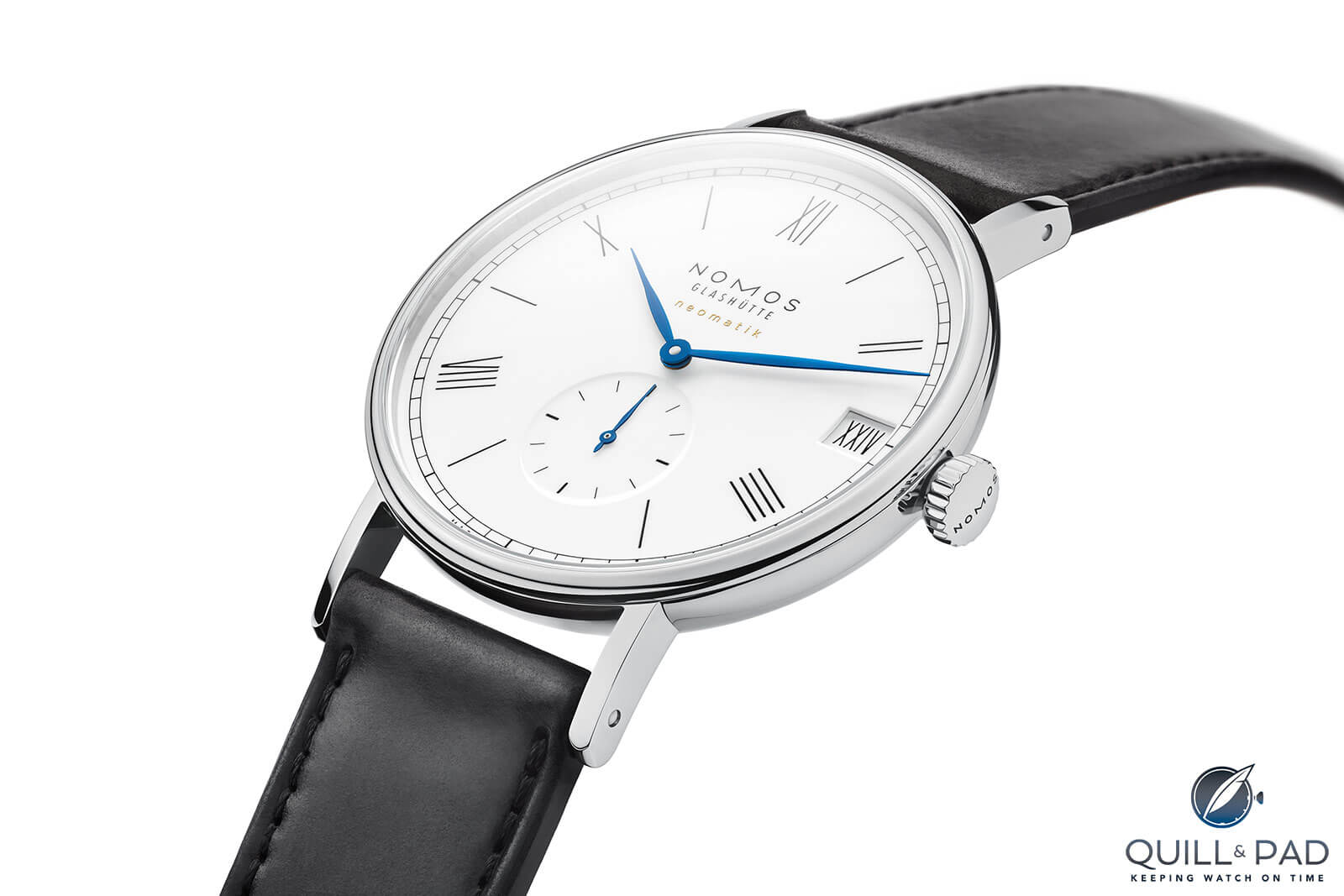
Nomos Glashütte Ludwig neomatik 41 Date
My favorite addition to the Nomos Glashütte range this year was quite surprisingly a timepiece from one of its five collections that would normally not be my first choice: Ludwig. This has been a staple from the very beginning of the company’s lineup but has not been in the spotlight as much as the legendary Tangente, which is today available in 19 variants.
However, I instantly fell in love with the shining-white lacquered dial and the Roman-numeral date indication of the Ludwig neomatik 41 Date – 175 Years Watchmaking Glashütte that was part of an anniversary trilogy Nomos introduced in the fall of 2020.
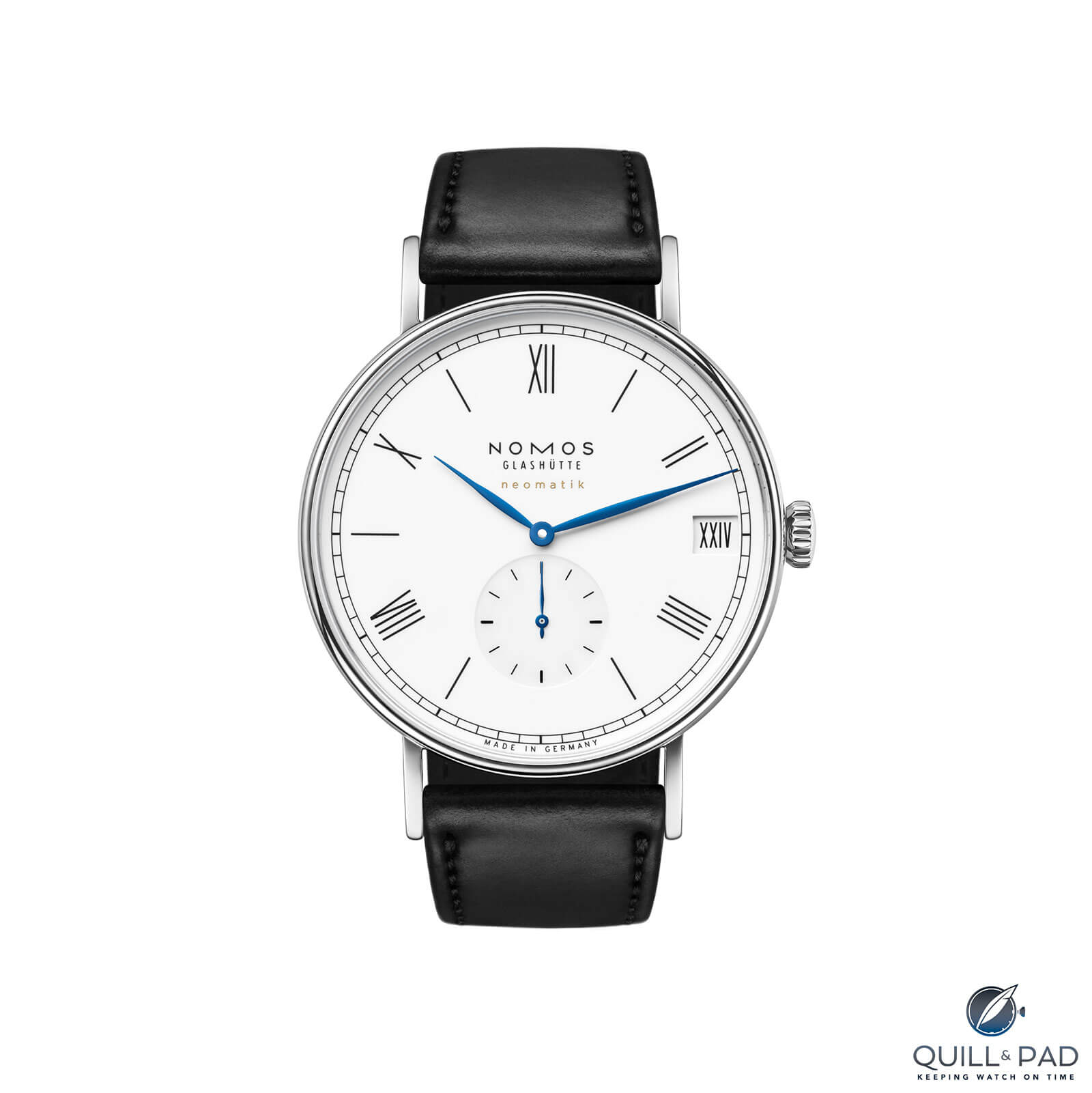
Nomos Glashütte Ludwig neomatik 41 Date
Ludwig is the only collection with Roman numerals and it also features a thin case. These have always been textbook dress watches, whether outfitted with a manual-winding or an automatic movement.
This new limited edition is no exception: it measures a mere 7.7 mm in height and comes with the brand’s signature Horween Genuine Shell Cordovan black leather strap. It is powered by the widely praised neomatik Caliber DUW 6101, which offers chronometric precision and a prominent, particularly legible date indication at 3 o’clock that can be set quickly and easily in both directions.

Unusual Roman numeral date of the Nomos Glashütte Ludwig neomatik 41 Date
The Roman numerals of the special edition highlight this watch’s classical appearance even more, making the watch quite unique. After all, there are not many timepieces in existence with a Roman numeral date – at least I don’t know of any!
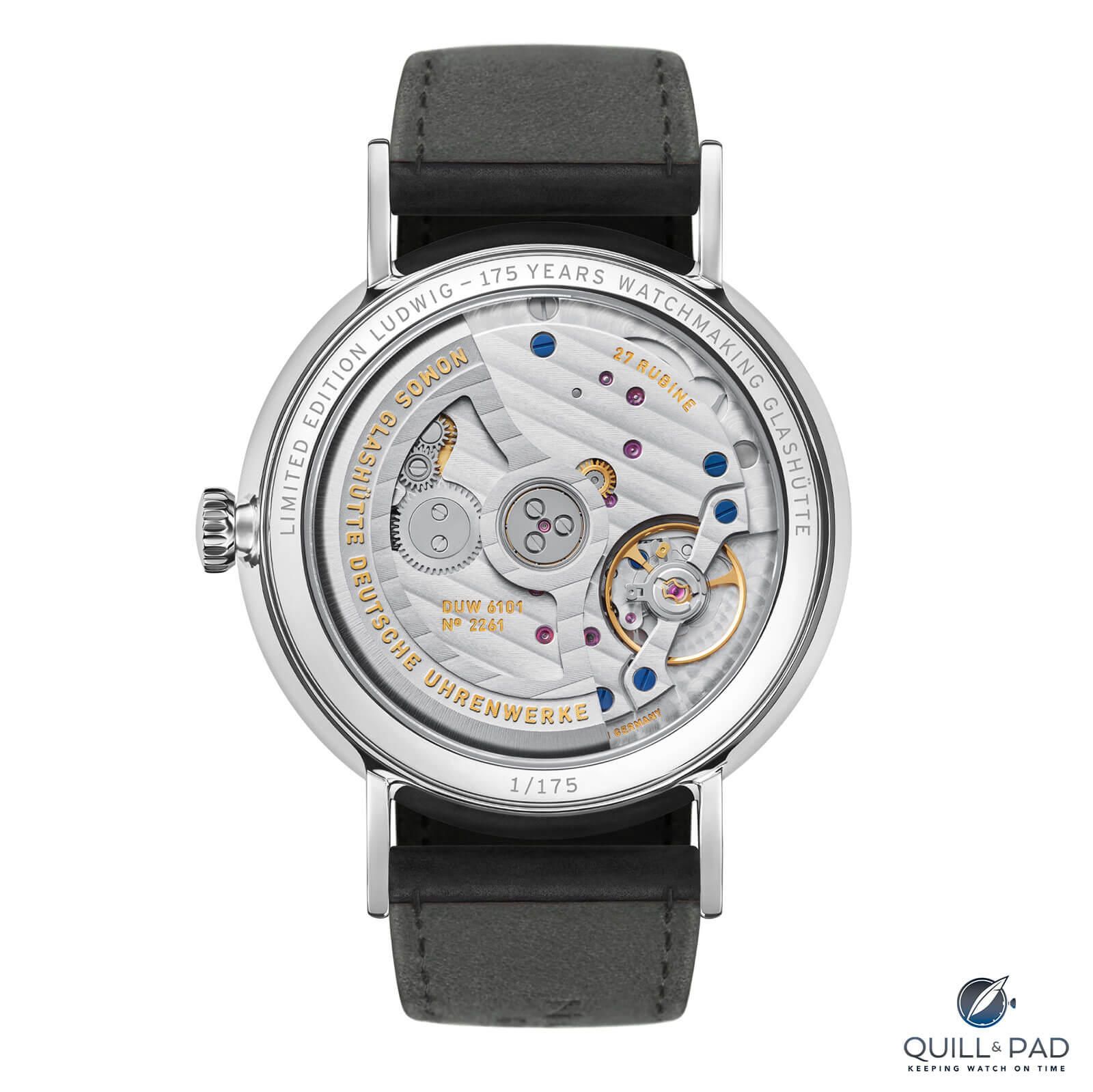
Movement visible through the display back of the Nomos Glashütte Ludwig neomatik 41 Date
Flipping a Nomos around is always a pleasure. Here, too, a sapphire crystal case back brings signature Glashütte-style decorations to light, including Glashütte ribbing, blued screws, perlage, and gold-plated engravings. Also on display is one of the company’s greatest technical achievements: its Swing System escapement distinguished by a tempered blue balance spring.
For more information, please visit www.nomos-glashuette.com/en/ludwig/ludwig-neomatik-41-date-175-years-watchmaking-glashutte.
Quick Facts Nomos Glashütte Ludwig neomatik 41 Date – 175 Years of Watchmaking Glashütte
Case: 40.5 x 7.7 mm, stainless steel
Movement: automatic Caliber DUW 6101, 4 Hz/28,800 vph frequency, 42-hour power reserve
Functions: hours, minutes, subsidiary seconds; date
Limitation: 175 pieces
Price: $4,200 / €3,300
You may also enjoy:
175 Years Of Watchmaking In Glashütte: A History Of Fine German Watchmaking
Nomos Glashütte Lambda In Stainless Steel: Celebrating 175 Years Of Fine Watchmaking In Glashütte
Leave a Reply
Want to join the discussion?Feel free to contribute!





















































What a nice, beautiful, spectacular selection of fine German watchmaking from Saxony. Great article, great images, what a joy to read. Thank you. It is a big surprise to see the birthday edition from Moritz Grossman with this outstanding dial and in a steel case.
The movements and the high level of finishing and decoration is outstanding. Impossible to decide for the most beautiful one.
For the moment it is really sad that the exhibition ‘How it all begann’ is closed due to the corona lockdown. I wish many visitors can see this exhibition in the next months to come. All the very best for 2021 … greetings, Thomas. Und immer schön fröhlich bleiben.
Thomas, I am glad you liked our compilation and thank you for your kind words. When it comes to Glashütte, there is such an abundance of history and watchmaking excellence, it is sometimes hard to find an end.
There is also a pink gold version of the XII Birthday Edition by Moritz Grossmann, which is just as beautiful as the steel execution.
I would also love to see the exhibition about the early days. I spoke with some people from the museum around this time last year. They told me it was not easy to compile information about and find originals from this period. I am sure they did a great job! My guess is that they will extend the exhibition until summer.
Alles Gute zum Neuen Jahr!
Sabine and Thomas, I had the good fortune to be able to see the exhibition on the day of its opening and even purchase a book that had been commissioned in honor of it on one of the earliest known movements. I can heartily recommend the exhibition and hope that they keep it open longer in light of the pandemic.